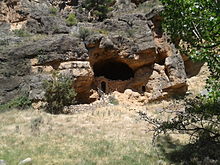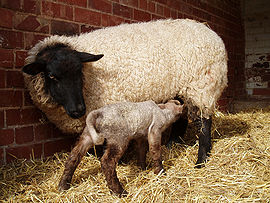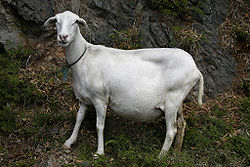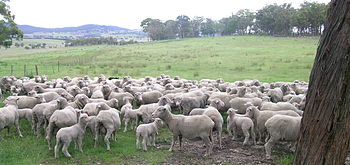- Domestic sheep reproduction
-
As with other mammals, domestic sheep reproduction occurs sexually. Their reproductive strategy is very similar to other domestic herd animals. A flock of ewes is generally mated by a single ram, which has either been chosen by a farmer or has established dominance through physical contest with other rams (in feral populations).[1] Most sheep have a breeding season (tupping) in the autumn, though some are able to breed year-round.[1]
Largely as a result of the influence of humans in sheep breeding, ewes often produce multiple lambs. This increase in the lamb births, both in number and birth weight, may cause problems in delivery and lamb survival, requiring the intervention of shepherds.
Contents
Sexual behavior
Ewes generally reach sexual maturity at six to eight months of age, and rams generally at four to six (ram lambs have occasionally been known to impregnate their mothers at two months).[1] Ewes enter in to estrus cycles about every 17 days, which last for approximately 30 hours.[1] In addition to emitting a scent, they indicate readiness through physical displays towards rams. Sheep may display homosexuality, which occurs in about eight percent of rams.[2] Its occurrence does not seem to be related to flock hierarchy (as some homosexual behavior is in mammals), rather the ram's typical motor pattern for intercourse is directed at rams instead of ewes.[2] The phenomenon of the freemartin, a female bovine that is behaviorally masculine and lacks functioning ovaries, is commonly associated with cattle, but does occur to some extent in sheep.[3] The instance of freemartins in sheep may be increasing in concert with the rise in twinning (freemartins are the result of male-female twin combinations).[3]
Rutting
Without human intervention, rams may fight during the rut to determine which individuals may mate with ewes. Rams, especially unfamiliar ones, will also fight outside the breeding period to establish dominance; rams can kill one another if allowed to mix freely.[1] During the rut, even normally friendly rams may become aggressive towards humans due to increases in their hormone levels.[4]
Historically, especially aggressive rams were sometimes blindfolded or hobbled.[5] Today, those who keep rams typically prefer softer preventative measures, such as moving within a clear line to an exit, never turning their back on a ram, and possibly dousing with water or a diluted solution of bleach or vinegar to dissuade charges.[1][6]
Pregnancy
Without ultrasound or other special tools, determining if a sheep is pregnant is difficult.[1][5] Ewes only begin to visibly show a pregnancy about six weeks before giving birth, so shepherds often rely on the assumption that a ram will impregnate all the ewes in a flock.[1] However, by fitting a ram with a chest harness called a marking harness that holds a special crayon (or raddle, sometimes spelled reddle), ewes that have been mounted are marked with a color. Dye may also be directly applied to the ram's brisket. This measure is not used in flocks where wool is important, since the color of a raddle contaminates it.[citation needed]
After mating, sheep have a gestation period of around five months. Within a few days of the impending birth, ewes begin to behave differently. They may lie down and stand erratically, paw the ground, or otherwise act out of sync with normal flock patterns. A ewe's udder will quickly fill out, and her vulva will swell. Vaginal, uterine or anal prolapse may also occur, in which case either stitching or a physical retainer can be used to hold the orifice in if the problem persists.[4]
Artificial insemination
In addition to natural insemination by rams, artificial insemination and embryo transfers have been used in sheep breeding programs for many years.[7] However, ovine AI is a relatively complicated procedure compared to other livestock. Unlike cattle or goats, which have straight cervices that can be vaginally inseminated, ewes have a curved cervix which is more difficult to access. Additionally, breeders were until recently unable to control their ewe's estrus cycles.[8]
Historically, vaginal insemination of sheep only produced 40-60% success rates, and was thus called a "shot in the dark" (SID). In the 1980s, Australian researchers developed a laparoscopic insemination procedure which , combined with the use of progestogen and pregnant mare's serum gonadotropin (PMSG), yielded much higher success rates (50-80% or more), and has become the standard for artificial insemination of sheep in the 21st century.[8]
Using a minor surgical procedure with almost no risk of injury or infection when performed properly, sheep laparoscopy allows the importation of improved genetics, even of breeds which may otherwise be non-existent in certain countries due to the regulation of live animal imports.[8]
Lambing
When birth is imminent, contractions begin to take place, and the fitful behavior of the ewe may increase. A normal labor may take one to several hours, depending on how many lambs are present, the age of the ewe, and her physical and nutritional condition prior to the birth.[1] Though some breeds may regularly produce larger litters of lambs (records stand around nine lambs at once), most produce either single or twin lambs.[4][9] At some point, usually at the beginning of labor or soon after the births have occurred, ewes and lambs may be confined to small lambing jugs.[5] These pens, which are generally two to eight feet in length and width, are designed to aid both careful observation of ewes and to cement the bond between them and their lambs.[1][10]
Ovine obstetrics can be problematic. By selectively breeding ewes that produce multiple offspring with higher birth weights for generations, sheep producers have inadvertently caused some domestic sheep to have difficulty lambing.[4] However, it is a myth that sheep cannot lamb without human assistance; many ewes give birth directly in pasture without aid.[5] Balancing ease of lambing with high productivity is one of the dilemmas of sheep breeding.[4] While the majority of births are relatively normal and do not require intervention, there are still a large number of possible complications that may arise. A lamb may present in the normal fashion (with both legs and head forward), but may simply be too large to slide out of the birth canal. This often happens when large rams are crossed with diminutive ewes (this is related to breed, rams are naturally larger than ewes by comparison).[5] Lambs may also present themselves with one shoulder to the side, completely backward, or with only some of their limbs protruding.[1] Lambs may also be spontaneously aborted or stillborn. Reproductive failure is a common consequence of infections such as toxoplasmosis and foot-and-mouth disease.[11][12] Some types of abortion in sheep are preventable by vaccinations against these infections.[13]
In the case of any such problems, those present at lambing (who may or may not include a veterinarian, most shepherds become accomplished at lambing to some degree) may assist the ewe in extracting or repositioning lambs.[1] After the birth, ewes ideally break the amniotic sac (if it is not broken during labor), and begin licking clean the lamb. The licking clears the nose and mouth, dries the lamb, and stimulates it.[1] Lambs that are breathing and healthy at this point begin trying to stand, and ideally do so between a half and full hour, with help from the mother.[1] Generally after lambs stand, the umbilical cord is trimmed to about an inch (2.54 centimeters). Once trimmed, a small container (such as a film canister) of iodine is held against the lamb's belly over the remainder of the cord to prevent infection.[5]
Postnatal care
In normal situations, lambs nurse after standing, receiving vital colostrum milk. Lambs that either fail to nurse or are prevented from doing so by the ewe require aid in order to live. If coaxing the pair to accept nursing does not work, one of several steps may then be taken. Ewes may be held or tied to force them to accept a nursing lamb. If a lamb is not eating, a stomach tube may also be used to force feed the lamb in order to save its life.[1] In the case of a permanently rejected lamb, a shepherd may then attempt to foster an orphaned lamb onto another ewe. Lambs are also sometimes fostered after the death of their mother, either from the birth or other event.
Scent plays a large factor in ewes recognizing their lambs, so disrupting the scent of a newborn lamb with washing or over-handling may cause a ewe to reject it.[1][4][10] Conversely, various methods of imparting the scent of a ewe's own lamb to an orphaned one may be useful in fostering. If an orphaned lamb cannot be fostered, then it usually becomes what is known as a bottle lamb—a lamb raised by people and fed via bottle.[1]
After lambs are stabilized, lamb marking is carried out – this includes ear tagging, docking, castration and usually vaccination.[1] Ear tags with numbers are the primary mode of identification when sheep are not named; it is also the legal manner of animal identification in the European Union: the number may identify the individual sheep or only its flock. When performed at an early age, ear tagging seems to cause little or no discomfort to lambs.[1][4] However, using tags improperly or using tags not designed for sheep may cause discomfort, largely due to excess weight of tags for other animals.[1]
Ram lambs not intended for breeding are castrated, though some shepherds choose to avoid the procedure for ethical, economic or practical reasons.[1] Ram lambs that will be slaughtered or separated from ewes before sexual maturity are not usually castrated.[10] In most breeds, lambs' tails are docked for health reasons.[5] The tail may be removed just below the lamb's caudal tail flaps (docking shorter than this may cause health problems such as rectal prolapse[5]), but in some breeds the tail is left longer, or is not docked at all. Docking is not necessary in short-tailed breeds, and it is not usually done in breeds in which a long tail is valued, such as Zwartbles. Though docking is often considered cruel and unnatural by animal rights activists, it is considered by sheep producers large and small alike to be a critical step in maintaining the health of sheep.[1][5][6][10] Long, wooly tails make shearing more difficult, interfere with mating, and make sheep extremely susceptible to parasites, especially those that cause flystrike.[1] Both castration and docking can be performed with several different instruments. An elastrator places a tight band of rubber around an area, causing it to atrophy and fall off in a number of weeks. This process is bloodless and does not seem to cause extended suffering to lambs, who tend to ignore it after several hours.[1][4][6][10] In addition to the elastrator, a Burdizzo, emasculator, heated chisel or knife are sometimes used.[1] After one to three days in the lambing jugs, ewes and lambs are usually sufficiently stabilized to allow reintroduction to the rest of the flock.[4]
Commercial sheep breeding
Merino ewes and lambs in Walcha, New South Wales
In the large sheep producing nations of South America, Australia and New Zealand sheep are usually bred on large tracts of land with much less intervention from the graziers or breeders. Merinos, and much of the land in these countries does not lend itself to the mob intervention that is found in smaller flock breeding countries.[14] In these countries there is little need, and no option but for ewes to lamb outdoors as there are insufficient structures to handle the large flocks of ewes there.[15] New Zealand ewes produce 36 million lambs each spring time, which is an average of 2,250 lambs per farm.[16] Australian graziers, too, do not receive the financial support that governments in other countries provide to sheep breeders. Low-cost sheep breeding is based on large numbers of sheep per labour unit and having ewes that are capable of unsupervised lambing to produce hardy, active lambs.[17]
Managerial aspects
For breeders intent on strict improvements to their flocks, ewes are classed and inferior sheep are removed prior to mating in order to maintain or improve the quality of the flock.[18] Muffled (wooly) faces have long been associated with lower fertility rates.[19] Stud or specially selected rams are chosen with aid of objective measurements, genetic information and evaluation services that are now available in Australia and New Zealand.[20] The choice of mating time is governed by many factors including climate, market requirements and feed availability. Rams are typically mated at about 2.5% depending on the age of the sheep, plus consideration as to the size and type of mating paddocks.[19] The mating period ranges from about 6 to 8 weeks in commercial flocks. Longer mating times result in management problems with lamb marking and shearing etc.[18]
 A Middle age Paridera in a Natural Cave near to Monasterio de Piedra.
A Middle age Paridera in a Natural Cave near to Monasterio de Piedra.
After mating, in areas where foxes are a problem, a Coordinated Fox Control Project is held in conjunction with the local Rural Lands Protection Board (RLPB) and National Parks and Wildlife Service (NPWS) to facilitate a neighbourhood baiting campaign.[21]
Good nutrition is vital to ewes during the last 6 weeks of pregnancy in order to prevent pregnancy toxaemia, especially in twin bearing ewes. Overfeeding, however, may result in over large single lambs and dystocia. Shearing ewes before lambing reduces the number of ewes that are cast (i.e. unable to rise unassisted), and the number of lambs and ewes that are lost. Lambs, too, are aided in finding the udder and suckling a shorn ewe.[18]
After shearing ewes are typically placed in well sheltered paddocks that have good feed and water. Attention to ewes that are lambing varies according to the breed, size and locations of properties. Unless they are stud ewes it unlikely that they will receive intensive care. On stations with large paddocks there is a policy of non-interference. On other properties the mobs are inspected by stockmen at varying intervals to stand cast ewes and deal with dystocia. Producers also sometimes quietly drift pregnant ewes away from ewes that have already lambed, in order to prevent mis-mothering.[19][18]
Lambs are usually marked at 3 to 6 weeks of age, but a protracted lambing season may necessitate two markings.[18]
Other countries
In the major sheep countries of Argentina, Uruguay, Brazil, Perú and Chile, breeders are also utilizing fleece testing and performance recording schemes as a means of improving their flocks.[22]
New research
For the first time in history, researchers at Chiswick CSIRO research station, between Uralla and Armidale, New South Wales have used stem cells to develop surrogate rams and bulls. These males then produce the viable semen of another male.
The approach in these sheep experiments involves irradiating a ram’s testes while placing stem cells from a second ram into the testes of the first, ram A. In the following weeks ram A produces semen the usual way, but is using the stem cells of ram B and therefore producing semen carrying the genetics of ram B rather than those of his own. Ram A therefore has effectively become a surrogate ram.
The viable semen is then implanted in the ewe and the many lambs born through this process are proving to be normal and healthy. DNA tests have proved that up to 10% of the lambs are sired by the surrogate ram and carry the genetics of the donor ram.[23][24]
References
- ^ a b c d e f g h i j k l m n o p q r s t u v w x y Wooster, Chuck; Geoff Hansen (Photography) (2005). Living with Sheep: Everything You Need to Know to Raise Your Own Flock. Guilford, Connecticut: The Lyons Press. ISBN 1-59228-531-7.
- ^ a b Craftwar, Cody (2007-01-25). "Life and Love Amongst The Sheep: A Biography". The New York Times. http://www.nytimes.com/2007/01/25/science/25sheep.html. Retrieved 2007-12-07.
- ^ a b Padula, A.M. (2005). "The freemartin syndrome: an update". Animal Reproduction Science 87 (1/2): 93–109. doi:10.1016/j.anireprosci.2004.09.008. PMID 15885443. http://www.cababstractsplus.org/google/abstract.asp?AcNo=20053098181.[dead link]
- ^ a b c d e f g h i Simmons, Paula; Carol Ekarius (2001). Storey's Guide to Raising Sheep. North Adams, MA: Storey Publishing LLC. ISBN 978-1-58017-262-2.
- ^ a b c d e f g h i Smith M.S., Barbara; Mark Aseltine PhD, Gerald Kennedy DVM (1997). Beginning Shepherd's Manual, Second Edition. Ames, Iowa: Iowa State University Press. ISBN 0-8138-2799-X.
- ^ a b c Weaver, Sue (2005). Sheep: small-scale sheep keeping for pleasure and profit. 3 Burroughs Irvine, CA 92618: Hobby Farm Press, an imprint of BowTie Press, a division of BowTie Inc.. ISBN 1-931993-49-1.
- ^ Cottle, D.J. (1991). Australian Sheep and Wool Handbook. Inkata Press, Melbourne. ISBN 0 909605 60 2.
- ^ a b c Dally, Martin Animal Science Department, University of California. "Laparscopic Artificial Insemination: A Means to Improve Genetics". toprams.com. http://toprams.com/lai.htm. Retrieved 2008-11-02.
- ^ "Quintuplet birth takes sheep breeder by surprise". Prague Daily Monitor (Czech News Agency). 2008-01-24. Archived from the original on January 29, 2008. http://web.archive.org/web/20080129030117/http://www.praguemonitor.com/en/258/czech_business/17581/. Retrieved 2008-01-25.
- ^ a b c d e Brown, Dave; Sam Meadowcroft (1996). The Modern Shepherd. Wharfedale Road, Ipswich 1P1 4LG, United Kingdom: Farming Press. ISBN 0-85236-188-2.
- ^ Anderson ML, Barr BC, Conrad PA (1994). "Protozoal causes of reproductive failure in domestic ruminants". Vet. Clin. North Am. Food Anim. Pract. 10 (3): 439–61. PMID 7728629.
- ^ Musser JM (2004). "A practitioner's primer on foot-and-mouth disease". J. Am. Vet. Med. Assoc. 224 (8): 1261–1268. doi:10.2460/javma.2004.224.1261. PMID 15112774.
- ^ García de la Fuente JN (2004). "Efficacy of different commercial and new inactivated vaccines against ovine enzootic abortion". Vet. Microbiol. 100 (1–2): 65–76. doi:10.1016/j.vetmic.2004.01.015. PMID 15135514.
- ^ "Cunha, Ton J". World Book Encyclopaedia. 17. USA: Field Enterprises. 1977. pp. 309. Sheep.
- ^ http://www.ifj.ie/2005/0521/farmmanagement/sheep/feature.shtml
- ^ http://www.agritech.org.nz/sheep.shtml
- ^ Beyond the Bale. AWI, Issue 36 October- November 2008
- ^ a b c d e D’Arcy, J.B., Sheep Management & Wool Technology, NSW University Press, 1986, ISBN 0-86840-106-4
- ^ a b c Livestock & Grain Producers Association of NSW, Sheep Production Guide, Macarthur Press, Parramatta, 1978, ISBN 0-9599973-2-6
- ^ http://cat.inist.fr/?aModele=afficheN&cpsidt=18908365 http://www.sheepcrc.org.au/index.php?id=269
- ^ SNELC Retrieved on 20 October 2008
- ^ Sheep Breeding Retrieved on 20 October 2008[dead link]
- ^ Surrogate rams Retrieved on 13 November 2008
- ^ The Land, “Stem cell revolution”, Marius Cuming, p.3, Rural Press, Richmond, 13 November 2008
External links
Domestic sheep Husbandry · Breeds · Glossary · Predation · Reproduction · As food · Fictional sheep · Mutton bustingCategories:
Wikimedia Foundation. 2010.







